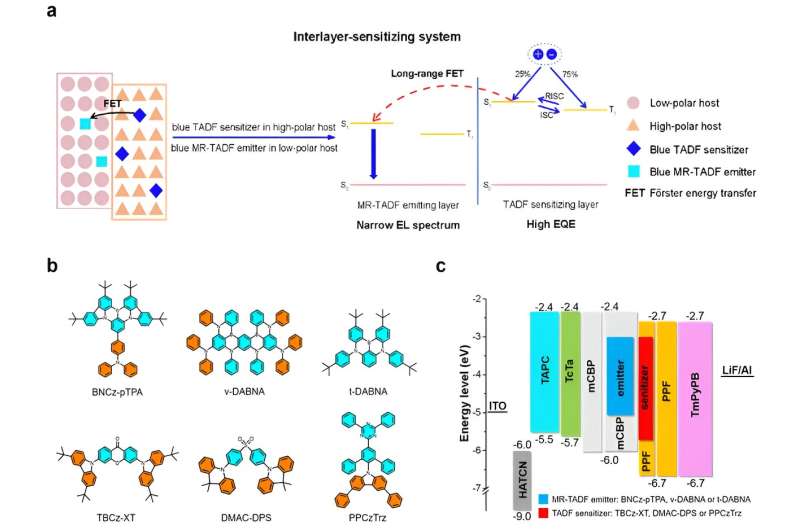This article has been reviewed according to Science X's editorial process and policies. Editors have highlighted the following attributes while ensuring the content's credibility:
fact-checked
peer-reviewed publication
proofread
Promising interlayer sensitization strategy for the construction of high-performance blue hyperfluorescence OLEDs

Multi-resonance thermally activated delayed fluorescence (MR-TADF) materials are promising candidates for organic light-emitting diodes (OLEDs) with narrow electroluminescence (EL) spectra. Scientists in China propose an interlayer sensitization strategy to improve EL efficiencies of blue MR-TADF emitters with blue MR-TADF sensitizer, and successfully realize blue hyperfluorescence OLEDs with high color quality and outstanding EL efficiencies simultaneously.
The results demonstrates the promising application of the interlayer sensitization strategy in the construction of high-performance blue hyperfluorescence OLEDs.
MR-TADF emitters are promising candidates for OLEDs with narrow EL spectra. However, many MR-TADF emitters suffer from serious triplet-involved quenching processes, which undermine EL efficiencies and cause sharp efficiency roll-offs and many current researches focus on addressing this issue by fabricating hyperfluorescence OLEDs.
But for optimizing blue MR-TADF emitters, the current sensitization strategy of co-doping MR-TADF emitters with TADF sensitizers in the same wide-energy-gap host layer may not be the best option because the polarity of a single host could be not suitable for both blue TADF sensitizer and blue MR-TADF emitter.
In a paper published in Light Science & Applications, a team of scientists, led by Professor Zujin Zhao from South China University of Technology, Guangzhou, China have developed an effective interlayer sensitization strategy for blue MR-TADF emitters, in which TADF sensitizer and MR-TADF emitter are separated into two adjacent emitting layers (EMLs) with different hosts, and MR-TADF emitters can be sensitized by TADF sensitizers via long-range Förster energy transfer (FET).
Based on this interlayer sensitization strategy, high-performance hyperfluorescence OLEDs using different blue MR-TADF emitters and different TADF sensitizers are prepared, furnishing strong blue light with narrow EL spectra and outstanding external quantum efficiencies (EQEs) of up to 38.8%, which are apparently improved in comparison with those of unsensitized devices.
These results demonstrate that this interlayer sensitization strategy is applicable for the fabrication of blue hyperfluorescence OLEDs with high EL efficiency and high color purity simultaneously.
More information: Jianghui Wang et al, Promising interlayer sensitization strategy for the construction of high-performance blue hyperfluorescence OLEDs, Light: Science & Applications (2024). DOI: 10.1038/s41377-024-01490-6
Journal information: Light: Science & Applications
Provided by Light Publishing Center, Changchun Institute of Optics, Fine Mechanics And Physics, CAS




















